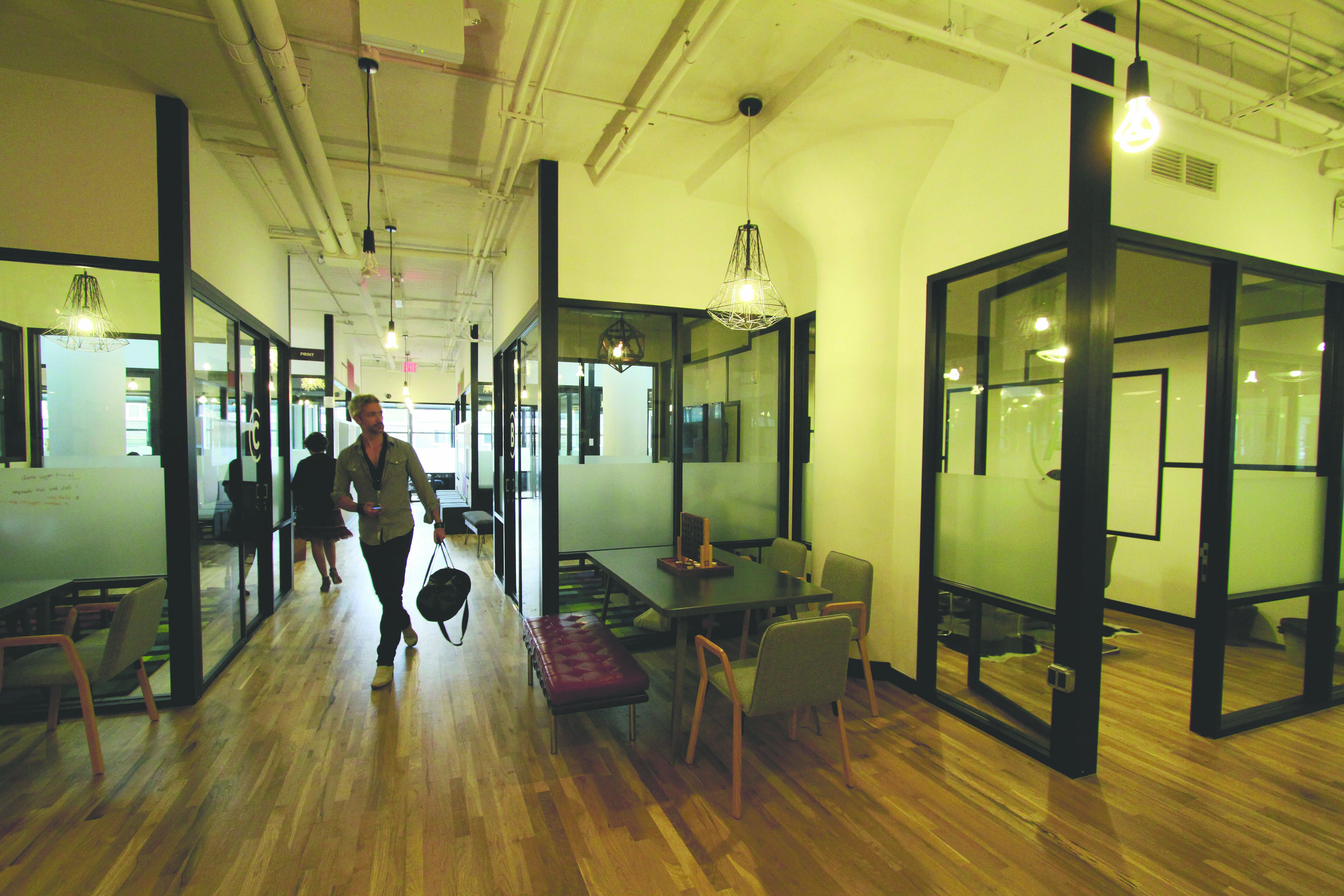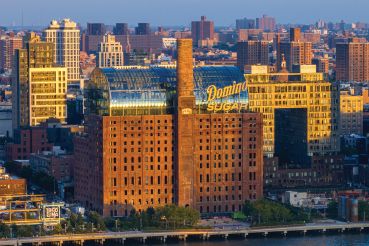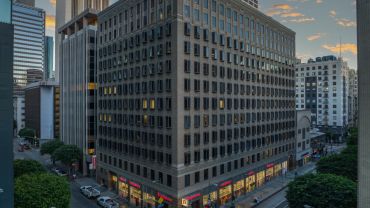Which Way is Up: Manhattan’s Market Boundaries are Beginning to Blur
By Al Barbarino April 16, 2013 8:00 am
reprintsFrom the outside, 222 Broadway fits the stereotype of the Downtown financial office tower.
But when Bank of America (BAC) downsized, leaving roughly 250,000 square feet of space vacant, a series of tours guided by its new owner, L&L Holdings, quickly blasted that stereotype away.
Condé Nast committed to 80,000 square feet at the tower in early March. WeWork (WE), which provides collaborative workspace for tech and media companies, was next in line.

“It’s an institutional-quality building,” said David Berkey of L&L. “But then you go up to these floors with these high windows, open floor plans and breathtaking views. They said, ‘Wow, people are going to love coming to work here.’”
WeWork already has offices in Soho, Midtown and the Meatpacking District, but its decision to create an outpost at 222 Broadway, where it inked more than 120,000 square feet in mid-March, is reflective of a shift that’s making Downtown a feasible or even attractive alternative to Midtown South for creative companies.
For Mr. Berkey, the shift is nothing new; he recognized the trend at another L&L building, 195 Broadway—where HarperCollins inked a 185,000-square-foot lease in the first quarter—about two and a half years ago.
“Before that, I was seeing financial firms, I was seeing law firms and insurance,” he said. “That’s over.”
Now, bolstered by first-quarter office leasing data, many claim that the invisible—yet mentally substantial—wall on Canal Street that once separated Midtown South’s young, hip upstarts from Downtown’s financial office base has eroded.
“The wall that used to exist along Canal Street is gone,” said Ken McCarthy, chief economist at Cushman & Wakefield (CWK).
For Downtown, it couldn’t have been more unlikely, following a year characterized by rising office vacancies and capped off with the devastation of Superstorm Sandy, but the area bounced back with a vengeance.
“Everyone was writing Downtown off—but it is continuing to exceed everyone’s expectations,” Mr. McCarthy said.
Downtown experienced what industry experts are calling a standout first quarter, with five of the city’s top 10 new leases being signed there and total leasing activity in the area hitting 1.7 million square feet, the highest since 2004, according to C&W.
The Downtown market outperformed Midtown and Midtown South for the first time in several quarters, as the availability of prime space at a significant discount gave it a competitive advantage and vacancy rates declined to 8 percent from 9.2 percent one year ago, the C&W data shows.
Midtown South and Downtown have historically been distinct in terms of their types of users, but now something of a melting pot is brewing, as tech tenants traditionally geared toward Midtown South (the nation’s tightest submarket) look Downtown, which is cheaper and often closer to the work force of creative tenants.
“The younger people involved in new media and tech can’t afford to live in Manhattan anymore,” Mr. Berkey said.
It’s working in both directions, too. Financial firms are a growing presence in Midtown South that was absent a decade ago. They now occupy 6.4 percent of the office space in Midtown South, which is up from zero a decade ago, according to C&W data.
The development at the World Trade Center site, along with the repositioned Brookfield Place, gives the area newfound legitimacy among tech clientele, especially with the transportation hub that will link Fulton Street to the new office space. Condé Nast’s decision to be the anchor tenant at 1 World Trade Center was the icing on the cake.
“It’s there, it’s developed, it’s beautiful,” said Colliers (CIGI) International President Joe Harbert. “The development down there has kept people alert to the fact that there’s a future Downtown. You couldn’t even find a place to eat there 15 years ago.”
Larry Silverstein told The Commercial Observer last month that 4 World Trade Center, scheduled to open this year, is about 50 percent leased, and that he is negotiating deals that will be sufficient to trigger financing for the completion of towers 2 and 3 under an agreement with the Port Authority of New York and New Jersey.
“It’s not a stalled situation anymore, where people are wondering what’s going to happen,” said C&W’s Gene Spiegelman. “Things are happening.”
But Midtown South’s availability and vacancy rates are still low enough to put substantial upward pressure on average asking rents, which reached $50.51 per square foot in the first quarter, up 18.7 percent from $42.55 per square foot a year ago, according to data from Colliers.
It’s “speculative pricing,” Mr. Harbert said, adding that despite data from other firms showing significant upticks in Midtown South vacancy rates, it’s still far from a tenant’s market.
Where the C&W data shows a year-over-year vacancy rate increase from 5.9 to 6.9 percent, for example, Colliers recorded a tick-down from 4.6 to 4.5 percent, which Mr. Harbert said has kept competition fierce.
“There’s heavy competition for space, and what you have is a change in landlord behavior,” Mr. Harbert said. “There’s a psychology to the market in Midtown South that it’s the destination that everyone wants to be in, that it’s really cool—and the owners are saying, ‘Ah, there is a heaven.’”
Google (GOOGL), which paid $1.8 billion for the 2.9-million-square-foot 111 Eighth Avenue in 2010, subleased 83,000 square feet at Chelsea Market in the first quarter, a testament to the continued interest in Midtown South among tech giants.
But no one is denying the revival of Downtown, where the record-setting leasing activity in the first quarter was bolstered by 280,000 square feet of positive absorption and availability dropped to 13.9 percent from 14.2 percent a year earlier, data from CBRE (CBRE) shows.
“I think you have a truly strong market when all three prime indicators, leasing activity, absorption and availability rate, are trending positively at the same time,” said Peter Turchin, executive vice president at CBRE, at a research breakfast this month.
Key deals in the first quarter included HarperCollins’s 185,000-square-foot lease at L&L’s 195 Broadway, which was the largest new lease completed in Manhattan, and the Condé Nast and WeWork deals at 222 Broadway. GfK Market Research also decided to move into the area south of Canal Street, where by some estimates roughly 20 percent of leasing in the first quarter was by technology and media firms.
Meanwhile, financial services firms are showing more resiliency than many would have foreseen months ago, when the doom and gloom of the European debt crises projected uncertainty. While Mr. McCarthy—and others, perhaps justifiably—noted that the financial sector is “lagging,” he conceded that the decline was 25 years in the making.
The latest data from the U.S. Bureau of Labor Statistics—which came out just as the quarter ended—shows that employment at financial services firms is down just 3 percent over the last decade. From the bottom of the market in January 2010, when there were 424,000 finance jobs in the city, that number has risen by roughly 11,000 (as of February), the data shows. While still below where it was at the peak of the market, financial services continued to provide about 25 percent of the total leasing volume Downtown in the first quarter, according to Colliers. By comparison, law firm activity was just 2.1 percent of the total.
The resurgence of Downtown and the consistency of Midtown South helped the Manhattan office sector record a solid first quarter, though there were signs of slowing momentum, as the overall availability and vacancy rates increased slightly and average asking rents saw minor declines, according to Colliers.
The Manhattan availability rate rose to 12 percent, up a tick from 11.9 percent in the fourth quarter of 2012, while the overall vacancy rate reached 6.1 percent, up from 5.8 percent in the fourth quarter, the firm said.
But it was Midtown, where the large financial services and other big corporate users generally follow the pulse of global economic trends, that provided the dead weight. While many of these firms have maintained resilience, they have been cautious, experts said.
Midtown’s availability rate is higher than it is elsewhere in the city, having gone up for six straight quarters, and pricing there declined during the last three.
But it’s a mixed bag. For example, Park Avenue availability hit 8.6 percent in the first quarter among Class A properties, while Lexington Avenue’s availability was 26.6 percent, data from Colliers shows.
Meanwhile, Midtown South will stay hot until its rents surpass Midtown—where the numbers can exceed $70 foot—which would perhaps spark a correction of the market, Mr. Harbert said. But he dispelled the notion that Midtown South is on the decline and called into question the idea of Downtown and Midtown South merging.
“I suspect there’s a blurring of the boundary lines there,” he said, referring to Canal Street. “But there’s a distinction between something blurring and merging. I don’t think tenants look at Midtown South and Downtown as equivalent markets … Downtown is not cool.”


